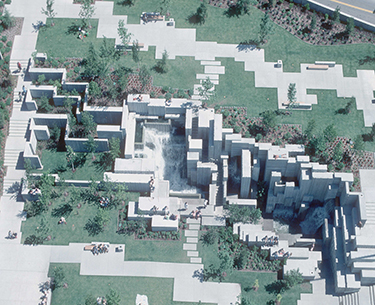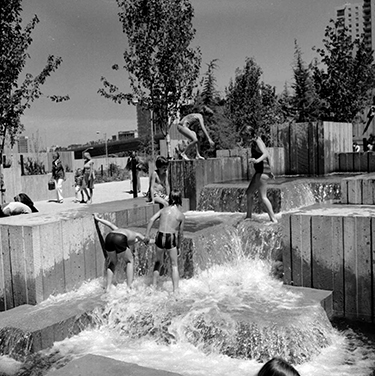|
Subscribe / Renew |
|
|
Contact Us |
|
| ► Subscribe to our Free Weekly Newsletter | |
| home | Welcome, sign in or click here to subscribe. | login |
Architecture & Engineering
| |
March 15, 2017
Group says design help is needed to make Freeway Park more inviting
Journal Staff Reporter
When Freeway Park opened above Interstate 5 in Seattle on July 4, 1976, it was a big hit as people flocked there to lie in the sun and enjoy the waterfalls.
“The water was at full capacity, so people were doing cannonballs into the fountain. It was a really different place,” said Riisa Conklin, executive director of The Freeway Park Association.
These days the 5.2-acre city park mostly just gets visitors during special events and conventions at the Washington State Convention Center next door.
It is also used as a thoroughfare between First Hill and downtown, except at night when most people stay out, Conklin said.
The association wants to change that. It plans to hire a landscape architect soon to create a conceptual design, using public input, for improvements and amenities.
This effort is especially timely as more high-rise housing is coming to First Hill, more people are working downtown, and the convention center is about to expand, said Conklin.
“Open public space, fresh air, and access to plants and wildlife is incredibly important to human health and well being, (and) to mental health and well being,” said Conklin, who has a master's in landscape architecture.
The park was designed by Angela Danadjieva and Lawrence Halprin, designer of Ghirardelli Square in San Francisco. Peterson Landscape Architects assisted.
The park is between Sixth and Ninth avenues, and Union and Spring streets. It was designed to reconnect downtown and First Hill, which had been severed by I-5.
The Cultural Landscape Foundation says the park is defined by irregular, linked plazas enclosed by board-formed concrete planters and walls.
The PBS documentary “10 Parks that Changed America” says Freeway Park is an example of how lidding highways can heal the fabric of a city.
But Conklin said the park is now mostly forgotten. Many people are unaware that Freeway Park exists while others don't feel safe there due to poor visibility. The meandering and often disorienting landscape compounds the sense that the space is unsafe, the association notes.
The park needs better lighting to highlight its unique landscape and encourage visitors, Conklin said.
Amenities such as a cafe, coffee stand, playground and restrooms would encourage people to linger. There are 12 entrances and exits, which should be clearly marked, she said, and better wayfinding is needed.
“The city has grown up very densely around Freeway Park and the design of the park has not responded to that density,” she said. “It was not intended to be hidden, but now it is hidden and we have to reveal it, and we have to be creative in how we do it.”
Drug dealing and other crime in the park led to safety improvements years ago, and Conklin said it has less crime today than other downtown parks, like Westlake and Occidental, but people still worry because it's empty a lot.
Freeway Park does not have businesses or housing nearby like other parks, she said, and high-rises cast shadows on it.
The city parks department contracts with the nonprofit to help steward Freeway Park.
Some major improvements have been made, including replacing some big trees and plants with smaller varieties to increase visibility.
No construction date has been set for the new improvements and amenities.
A city grant is providing $22,500 for the first phase of planning. The FPA likely will employ that architect on the final design, which will be used to seek donations and grants. FPA also is seeking public benefit money from the convention center in connection with that expansion.
But even mentioning changes to such an iconic landscape could ruffle feathers. That's what the Seattle Asian Art Museum found with its plan to expand in Volunteer Park, which was designed by the Olmsted Brothers.
“I think people get prickly when we talk about changing Freeway Park because it's such an honored, important place,” said Conklin. But, she said, the park needs to “respond to the changing, growing nature of our city.”
FPA will work with stakeholders, including The Cultural Landscape Foundation, on the plan.
Iain Robertson, an associate professor at the University of Washington's Department of Landscape Architecture, worked with retired landscape architect Ted Holden on replacing trees and plants in the park. Robertson said he also discussed it with Lawrence Halprin before he died, and said Halprin was enthusiastic and supportive.
“This is akin to a landscape architect going and talking to God,” said Robertson, who called Halprin an icon of landscape architecture throughout the 20th century.
Robertson said the park is made up of city-scaled window boxes with vegetation, reflecting the Brutalist style of the 1960s and 70s. It appears as a series of canyons and rooms — a reflection of both the surrounding freeway and Halprin's desire to create a experience where parts are revealed sequentially to visitors.
Robertson lauded FPA's stewardship of the park. He said it's important to be respectful, but not “deferential” to the original design when making changes.
“I don't believe that we should tie ourselves to what's there,” he said, because Seattle is a very different place than it was in 1976.
Freeway Park's land is immensely valuable, but it's not getting adequate use, he said. “It can't remain static. It has to remain responsive.”
Lynn Porter can be
reached by email or by phone
at (206) 622-8272.




